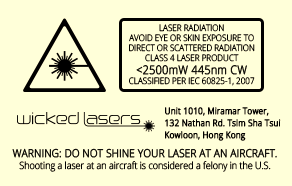Home
A comprehensive resource for safe and responsible laser use
US: Child suffers eye injuries from adult misusing high-powered blue laser
The case was reported in JAMA Ophthalmalogy under the title “Ocular Safety of Recreational Lasers.” Authors Glenn Yiu, Sujit Itty and Cynthia Toth are with the Department of Ophthalmology at Duke University Medical Center in Durham, North Carolina.
They described the boy’s injuries as being caused by a Spyder III Pro Arctic “a class 4, high-powered 1250 mW laser that is manufactured from the 445 nm blue diode of a dismantled home theater projector and that is commercially available for online purchase from overseas.” This brand of laser is manufactured by the company Wicked Lasers; an 800 mW version was reviewed here.
In the case they described, “the adult directed the laser at the child’s eyes in jest, unaware of the harmful consequences.”

A copy of the safety label that appears on a Wicked Laser Spyder III Pro Arctic, containing the IEC and U.S. FDA-mandated wording for a Class 4 laser: “Avoid eye or skin exposure to direct or scattered radiation”
According to the authors, “imaging studies suggest that the laser damage was limited to superficial retinal vessels with no involvement of the underlying retinal pigment epithelium or choroid. To our knowledge, this is the first report of a continuous wave laser in the visible spectrum–damaging retinal vessels without affecting the retinal pigment epithelium, the site where damage from visible lasers typically occurs.”
They speculate that this may be caused by greater absorption of shorter wavelength lasers by hemoglobin, or a defocusing of the laser due to chromatic aberration and myopia in a child.
The authors conclude that “with the expanding use of lasers in nonoccupational or recreational settings, escalation of laser safety awareness and consumer laser regulations is paramount to prevent future ocular laser injuries.”
From JAMA Ophthalmology, published online January 09, 2014. doi:10.1001/jamaophthalmol.2013.5647. Thanks to Dr. David Hunter for bringing this to our attention.